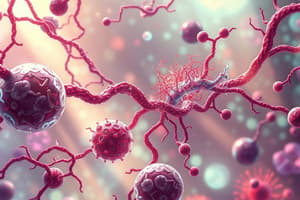Podcast
Questions and Answers
What are the two main types of cells?
What are the two main types of cells?
Prokaryotic and eukaryotic cells
What is the main difference between prokaryotic and eukaryotic cells?
What is the main difference between prokaryotic and eukaryotic cells?
- Energy transformation
- Presence of nucleus (correct)
- Reproduction method
- Size
What does metabolism transform?
What does metabolism transform?
Matter and energy
Which of the following is NOT a form of energy?
Which of the following is NOT a form of energy?
Life is defined as a system that can independently rearrange matter.
Life is defined as a system that can independently rearrange matter.
What is the biological information stored in?
What is the biological information stored in?
What is Ecology the study of?
What is Ecology the study of?
_____________ ecology examines how interactions between species affect community structure.
_____________ ecology examines how interactions between species affect community structure.
What does the biosphere encompass?
What does the biosphere encompass?
The biosphere is an open system with regard to energy.
The biosphere is an open system with regard to energy.
Study Notes
Review of Lecture 2
- Organelles are the structural and functional units within cells.
- Cells are composed of coordinated organelles.
- There are two main types of cells: prokaryotic and eukaryotic.
- Eukaryotic cells are compartmentalized by membranes.
- Metabolism is the process of transforming matter and energy.
- Energy is the ability to rearrange matter.
- Different forms of energy include kinetic, thermal, and potential.
- Life is a self-controlled system capable of rearranging matter and energy.
- Life is highly ordered and can reproduce.
- Reproduction preserves information through a code passed to offspring.
- DNA stores biological information as nucleotides.
- Cell division creates new life and transfers genetic information to offspring.
- Variation introduces new biological information.
Basics of Ecology
- Ecology is the study of interactions between organisms and their environment.
- Different hierarchical levels of ecology exist.
- Organismal ecology studies how an organism's structure, physiology, and behavior adapt to its environment.
- Population ecology analyzes factors that affect population size and its changes.
- Community ecology investigates how species interactions influence community structure.
- Ecosystem ecology focuses on energy flow and chemical cycling within ecosystems.
- Landscape ecology examines the exchange of energy, materials, and organisms across landscapes.
- Global ecology studies how regional exchange impacts the biosphere.
The Biosphere
- The biosphere encompasses all ecosystems and landscapes on Earth.
- It is a closed system in terms of matter, with minimal inputs and outputs.
- It is an open system in terms of energy.
Studying That Suits You
Use AI to generate personalized quizzes and flashcards to suit your learning preferences.
Related Documents
Description
This quiz reviews key concepts from Lecture 2, focusing on cell structure, organelles, types of cells, metabolism, and reproduction. Additionally, it introduces the basics of ecology, exploring interactions between organisms and their environment, along with different levels of ecological study.




